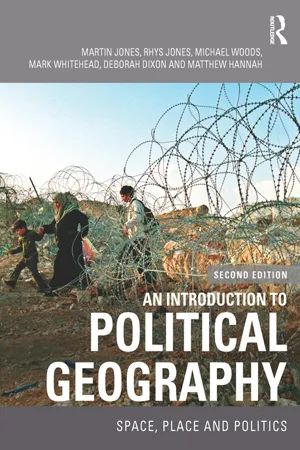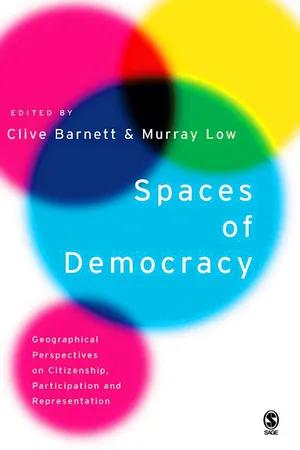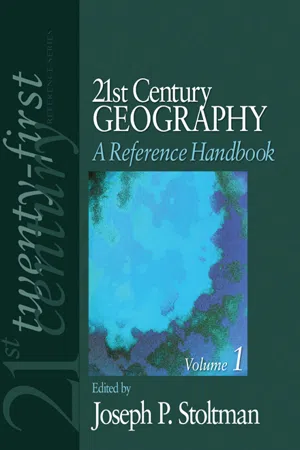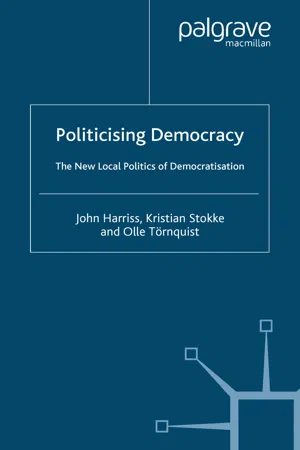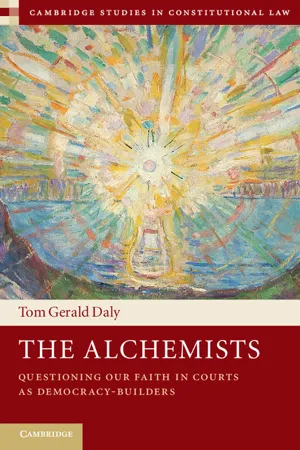Geography
Democratisation
Democratisation refers to the process of transitioning from an authoritarian or non-democratic political system to a democratic one. This process involves the establishment of democratic institutions, such as free and fair elections, an independent judiciary, and a free press. Democratisation can have significant impacts on a country's political, social, and economic development.
Written by Perlego with AI-assistance
Related key terms
1 of 5
8 Key excerpts on "Democratisation"
- eBook - ePub
An Introduction to Political Geography
Space, Place and Politics
- Martin Jones, Rhys Jones, Michael Woods, Mark Whitehead, Deborah Dixon, Matthew Hannah(Authors)
- 2014(Publication Date)
- Routledge(Publisher)
7Geographies of representation and mobilisationIntroductionThis chapter will focus on the way in which political formations shape and are energised by processes and possibilities of democracy. We will argue that democracy in all its forms is thoroughly geographical. This includes not only the outcomes of electoral democracy – where voting patterns are geographically differentiated, and where the territorial structure of electoral systems can change results – as discussed in the first half of the chapter, but also more participatory forms of democratic mobilisation – for example, through social movements – which the second half of the chapter will discuss.‘Democracy’ (the word was coined in Ancient Greece to denote the rule or power [kratia ] of the people [demos ]) refers in the broadest sense to any process in which many, most or all of the people affected by decisions are able to participate in making or influencing those decisions. Democracy can thus play a role in all spheres of social life, from the family to the workplace or economy to international relations. This chapter will focus primarily on political democracy, the sphere of public participation in or influence over the policies and decision-making processes of states. However, it is important to bear in mind that no strict boundary can be drawn between political democracy and cultural or economic democracy.Political democracy is now recognised by many people around the world as the chief source of the legitimacy of states, though the expansion of democratic institutions and practices among states has not been constant or geographically uniform (see Box 7.1 - eBook - ePub
Spaces of Democracy
Geographical Perspectives on Citizenship, Participation and Representation
- Clive Barnett, Murray Low, Clive Barnett, Murray Low(Authors)
- 2004(Publication Date)
- SAGE Publications Ltd(Publisher)
1Geography and Democracy: An Introduction
Clive Barnett and Murray Low
Where is Democracy?
Amid debates about globalization, neo-liberalism, and anti-capitalism, it is easy to forget that probably the most significant global trend of the last two decades has been the proliferation of political regimes that claim to be democracies. Democracy refers to the idea that political rule should, in some sense, be in the hands of ordinary people. It is also a set of processes and procedures for translating this idea into practices of institutionalized popular rule. In a remarkably short space of time, commitment to democracy has become near universal. The universalization of democracy as an ideal, if not as a set of agreed-upon practices, is historically unprecedented: ‘Nothing else in the world which had, as far as we can tell, quite such local, casual, and concrete origins enjoys the same untrammeled authority for ordinary human beings today, and does so virtually across the globe’ (Dunn, 1992: 239). This assertion pinpoints one key geographical dimension of the contemporary ascendancy of democratic norms. This is the problematic relationship between the particular historical-geography of democracy’s ‘origins’ on the one hand, and democracy’s more recent globalization on the other. However, it is striking how little impact processes of democratization, or democracy as a broader theme, have had on research agendas in human geography. While a great deal of critical analysis is implicitly motivated by democratic norms, there is relatively little empirical research or theoretical work that explicitly takes democracy to be central to the human geographic endeavour. This book aims to address this lacuna, by bringing together contributions from across the discipline of geography, addressing various research fields in which democracy is often a veiled backdrop, but not usually a topic of explicit reflection. We hope the book will thereby help to encourage the sort of detailed attention to issues of normative political theory that has recently been called for by others (Agnew, 2002: 164–78). - eBook - PDF
Transnational Mobilization and Domestic Regime Change
Africa in Comparative Perspective
- H. Schmitz(Author)
- 2006(Publication Date)
- Palgrave Macmillan(Publisher)
11 2 Transnational Dimensions of Democratization Chapter 2 deals with two concepts. 1 The first two sections define democracy as a political system maximizing popular participation organized in periodic electoral contests. The rest of the chapter adds a transnational dimension to the comparative study of democratization. The transnational mobilization for democratic change is particularly relevant in challenging authoritarian rule. In later stages external influences combine with domestic factors to produce variation in the paths of regime change. Transnational mobilization not only decreases in importance during later stages of regime change, but also produces more ambiguous effects on democratic change. External actors find it easier to join domestic groups in challenges to authoritarian leaders than to contribute positively to the creation and consolidation of democratic practices. Defining democratic practices Democratization is a process, which increases popular participation and electoral contestation. Effective participation and competition require a measure of equality among the populace as well as transparency and accountability of the rulers to the ruled. The claim of participation in public affairs is frequently based on the assumption that human beings share intrinsic qualities and are capable of determining their own affairs, both individually and collectively. Comparing democratic rule across nations entails significant issues of definition and measurement. Should a definition of democracy prima- rily focus on the selection process of leaders or should it include refer- ences to the broader social and cultural structure of a society? The more narrow definition of democracy reflects a pluralist view (Dahl 1971; Schumpeter 1942) and is used here for two primary reasons. First, by - eBook - PDF
- Joseph P. Stoltman(Author)
- 2011(Publication Date)
- SAGE Publications, Inc(Publisher)
These analyses provide valuable insights into the cultural, eco- nomic, and social geographies of various areas within particular societies. Electoral geography also involves understanding of how electoral systems operate in geo- graphical context. The process by which individual votes are counted is often crucial to election outcomes and, therefore, to campaign strategies implemented and used by political parties. The purpose of this chapter is to provide an overview of electoral geography and of voting from a geographic standpoint. Discussion of democracy and voting in histori- cal context is followed by more detailed analysis of con- temporary elections and electoral systems, emphasizing the U.S. presidential election of 2008 and recent elections in other countries. This analysis is followed by discussion of the future of elections and electoral geographies in the years ahead. Democracy and Voting in Historical Context Democracy as we know it today is a product of the past 2 centuries. After becoming independent following the American Revolution, the United States became the first 207 208 • HUMAN GEOGRAPHY country to practice democracy on a large scale. However, in the late 18th and early 19th centuries, voting and politi- cal participation were limited to white male property own- ers. Since the early 19th century, we have seen a steady increase in the number of countries in different regions of the world that practice democracy. The percentage of adult residents holding citizenship and voting rights in all coun- tries has also increased steadily. Expanding the Franchise In the United States, property ownership requirements for voting were eliminated before the Civil War, and all white males over age 21 were eligible to vote throughout the country. Women and nonwhites were often barred from participation. - eBook - PDF
Diffusion of Democracy
The Past and Future of Global Democracy
- Barbara Wejnert(Author)
- 2014(Publication Date)
- Cambridge University Press(Publisher)
Following James’s (1993) argument, externalities would have a permissive effect, where their presence or absence would largely determine a country’s decision to adopt or not adopt a democratic system. Geographical settings Many studies of diffusion are concerned with a specific category of geographical settings: the effect of the spatial factor of proximity (distance) on democracy’s adoption. This variable refers to an auto- matic spread of democracy between individual countries that are in close geographical contiguity, such as within groups of countries located within the same geographical region. Geographical proximity is generally estimated as the relative rate of adoption between geo- graphically spaced actors. Because proximity can affect the frequency 62 Factors contributing to democratization of communication and the direct nature of interactions between coun- tries, it enhances the spread of information and ideas, and facilitates imitative behavior (Rogers 1995). Abbott and DeViney (1992), dis- cussing the diffusion of welfare policy across the world, added that geographic proximity alone does not have a very significant effect on a country’s adoption of welfare policy unless it is supported by countries’ closeness in interaction, e.g., comparability in trade, capital flow, language, or religion. Frequently, the effect of geographical proximity is visible in cases of the adoption of the principles of democracy by countries located within the same geographical region in the world (Huntington 1992), especially when these countries share cultural characteristics and are engaged in mutual capital flow and trade. Thus, Tolnay (1995) argued that the effects of density of potential adopters of democracy are a function of geographical proximity or distance between states, and, hence, spatial effects are best estimated as a joint function of distance and density. - eBook - PDF
Politicising Democracy
The New Local Politics of Democratisation
- J. Harriss, K. Stokke, J. Harriss, K. Stokke, Kenneth A. Loparo, Olle Törnquist(Authors)
- 2004(Publication Date)
- Palgrave Macmillan(Publisher)
There are few critical analyses of whether this localisation actually generates the expected outcomes, especially in terms of Democratisation. Existing studies commonly emphasise the crafting of local institutions of governance and downplay local politics. This collection aims at filling this gap. Our purpose is to examine the conjunction of discourses and institutions that define local political spaces and the political practices of actors operating within these spaces, with a special emphasis on the implications of local politics for Democratisation. Democratic transitions in the context of globalisation These processes of globalisation and localisation of politics coincide and relate to contemporary democratic transitions, what Samuel Huntington famously described as ‘the third wave of Democratisation’ (Huntington 1991). 4 One set of calculations shows that 69 per cent of the countries of the world had authoritarian regimes in 1975, while only 24 per cent could be described as liberal democracies. By 1995 these proportions stood at 26 per cent and 48 per cent respectively. The proportion of countries that could be described as being liberal democracies had doubled over 4 Politicising Democracy 20 years (Potter 1997). Another calculation is that ‘In the 1980s and 1990s . . . some 81 countries took significant steps towards democracy’ (UNDP 2002: 1). In some ways the occurrence of this wave of democra- tisation (meaning, simply, ‘political changes moving in a democratic direction’: Potter 1997: 3) 5 is surprising, since those social conditions that have been most important historically in bringing about democracy seem to have been reduced by globalisation, and they have certainly not very commonly been present in the countries that have undergone some degree of Democratisation. - eBook - PDF
The Alchemists
Questioning our Faith in Courts as Democracy-Builders
- Tom Gerald Daly(Author)
- 2017(Publication Date)
- Cambridge University Press(Publisher)
The chapter first examines the ways in which Democratisation as a concept is used and how it relates to these other terms of art in the literature on democracy-building. The chapter then discusses the meaning of 1 The term is used by a variety of organisations, including the European Union, United Nations, and International IDEA. Democratisation in Democratisation theory and lays out a minimal ana- lytical framework for discussing Democratisation and the courts in the following chapters. The framework, we will see, focuses in particular on the concept of ‘consolidation of democracy’, which is refined for the purposes of the book by exploring the relationship between democrati- sation, democracy, and constitutionalism, at both the domestic and regional levels. 1 The Prevalence of ‘Democratisation Talk’ in Law and Policy Today Law, policymaking, and scholarship have become increasingly suffused with ‘Democratisation talk’ in recent decades. Consider the following samples: Democratization is a process which leads to a more open, more partici- patory, less authoritarian society. Democracy is a system of government which embodies, in a variety of institutions and mechanisms, the ideal of political power based on the will of the people. Boutros Boutros-Ghali, An Agenda for Democratization, 1996 2 CONSIDERING that . . . one of the purposes of the OAS is to promote and consolidate representative democracy, with due respect for the principle of nonintervention; . . . REAFFIRMING that the participatory nature of democracy in our countries in different aspects of public life contributes to the consolidation of democratic values and to freedom and solidarity in the Hemisphere; Inter-American Democratic Charter, 2001 3 The Council of Europe’s philosophy has always been to provide a ‘school for democracy’ under which [‘hybrid regimes’] would gradually deepen their commitment to democratic consolidation. - eBook - PDF
Bosnia
Faking Democracy After Dayton
- David Chandler(Author)
- 2000(Publication Date)
- Pluto Press(Publisher)
1 Democratisation This chapter provides an overview of the dominant ideas that have shaped international institutional intervention in Bosnia – the framework of Democratisation. It will be argued that, although the language of Democratisation appears universal, its content today is a highly ideological one that qualifies liberal democracy in the states of Eastern Europe and justifies the interference of Western institutions in their domestic affairs. There are two key components of the current approach to Democratisation that are interlinked and mutually reinforcing: first, the shifting definition of democracy itself, with less focus on the institutional level of elections and government process and more on the imputed values and culture of a society, and second, the internationalisation of questions of democratic consolidation, where the problems of Democratisation are held to necessitate international institutional guidance and support. These two elements form the bulk of this overview, which concludes with the application of this approach to the context of Bosnia. FROM DEMOCRACY TO Democratisation Until the early 1990s, ‘Democratisation’ was the loose term for describing the process of establishing liberal or constitutional democracies along the lines of Western European or US models. This process has been analysed in the field of political science by commentators such as Samuel Huntington, most notably in The Third Wave: Democratization in the late Twentieth Century (1991a; see also O’Donnell et al., 1986 and Diamond et al., 1989). During this period, the ‘transition to democracy’ or the ‘Democratisation process’ was seen as a global process in successive waves.
Index pages curate the most relevant extracts from our library of academic textbooks. They’ve been created using an in-house natural language model (NLM), each adding context and meaning to key research topics.
